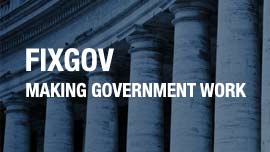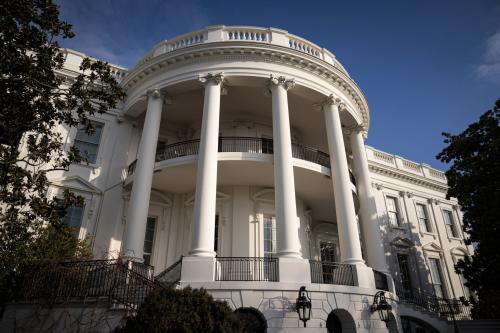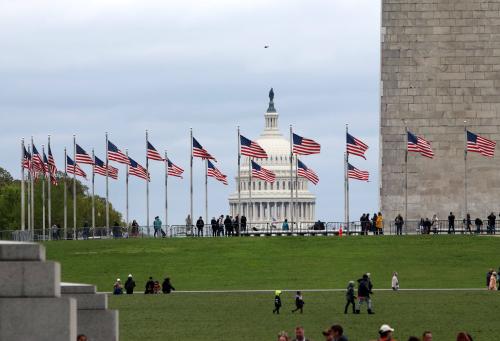Editor’s Note: Previously on the FixGov Blog, Dorothy Robyn wrote an article arguing for the corporatization of air traffic control. In this post, Robert W. Mann, Jr. responds to Robyn’s proposal.
Dorothy Robyn’s recent contribution to Brookings FixGov Blog (“It’s time to corporatize air traffic control (the right way)”, September 28, 2015) proposes changes to the structure and funding of U.S. Air Traffic Control (ATC) management and operation, as well as its modernization, changes claimed to benefit air carriers and business/general aviation users, air travel consumers and taxpayers.
It would be difficult not to criticize the sorry state of air travel, ATC system and upgrade delays, and associated higher costs imposed on all concerned. Congressional oversight agencies agree.
While change is needed, it is important to carefully note what (if anything, specifically) the Robyn proposal is selling—or is it obfuscating? Any proposal must first meet the test of Primum non nocere, “First, do no harm.” And advocates of change need to acknowledge how stakeholders’ self-help could address the present state of delays and appearance of system capacity shortages, right now, while also optimizing according to their own business rules, without any need for equipage or structural change.
Ms. Robyn argues for change in governance structure and funding, without specifying what or how, exactly. The argument raises a series of questions that need serious answers. How it will impact various ‘stakeholders’ and constituencies—airlines, business and general aviation, airports, communities, air travelers? What is the proposed organizational structure—who will really have a ‘say’ (or has already had one) and in what proportion, on what basis, on the presumed ‘corporatized’ board? What would user costs and benefits be, how achieved, how funded, and how apportioned among airline, business and general aviation, airport, air travel consumer and taxpayer constituencies? What equipment mandates by what date will be required? Are we presuming modernization (commonly called NextGen) upgrades will still be made by 2020 or 2025, as is laid out in current mandates? In fact, those are the sorts of decisions (as yet unspecified) that are exactly the policy/trade-off issues which Ms. Robyn states ‘corporatization’ avoids, but may have internalized—assuming it has addressed or decided them at all.
In addition, the use of the Canadian privatized model (NAV Canada) as a cost and performance benchmark and comparison to our U.S. operations isn’t a particularly good or close one, on a variety of metrics like structure, scope/constituency, scale and costs/charges. The Canadian aviation market is 10% of the size of the U.S. market, and 90% of Canadian aviation operations occur within 200 miles of the U.S. border. Comparisons with NAV Canada’s costs do not take into account the near historic low in Canadian-US Dollar exchange rate, and that NAV Canada funding benefits disproportionately from overflight fees that a corporatized U.S. ATC operation likely will not experience at comparable levels.
I’m no apologist for FAA/government procurement, but how exactly would a corporatized U.S. ATC operation do it differently? In my experience, ‘stakeholder’ airlines don’t specify, build, buy, or operate information technology solutions particularly well or cost-effectively, even when highly competitive suppliers exist. There may not be commercial or risk-sharing parties willing to undertake systems software development on terms other than those offered by the ‘the usual suspects’ who have been FAA ATC and communications systems software suppliers for decades. (Those systems, it should be noted have often been late and over budget.)
Also, note that airline stakeholders say they endorse NextGen, but don’t walk the walk—only a small percentage of air carrier fleets are meeting what was originally a year 2020 equipage mandate.
If there really is a need for structural change, and there is, airline stakeholder advocates should start by facing up to the fact that they are in a unique position to stabilize their own flight arrival and departure flows, mitigate flight delays, reduce their own operating costs (and costs they impose on others), better utilize existing National Airspace System and airport capacity, and in so doing, relieve FAA of reactive workloads created by unmanaged aircraft flows, while providing more reliable, on-time operations and productivity to air travel consumers. Only after invoking self-help should they be arguing for structural change. You broke it; you fix it, first.
Legislative debate on ‘structural change’ is traditional in Washington also does not often produce good outcomes. This debate often results in unrelated riders, re-introduces or expands safety and operational aspects of current FAA scope, and rehashes funding issues. And on top of all of that, social policy amendments always creep in toward the end.
Summarizing, I restate my original concern, “First, do no harm.” This is far from assured in current industry and legislative proposals, since there are no specific changes to evaluate, whether good or bad.
Be careful what you ask for, lest you get it—or the ever-present unintended consequences. Let’s evaluate specifics, and then make informed decisions about reform of our air transportation system.
The Brookings Institution is committed to quality, independence, and impact.
We are supported by a diverse array of funders. In line with our values and policies, each Brookings publication represents the sole views of its author(s).




Commentary
For air traffic control reform, first, do no harm
November 5, 2015